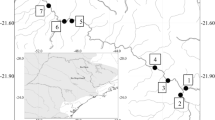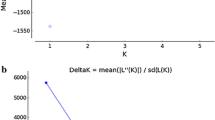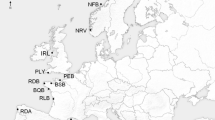Abstract
The presence of interspecific hybrid surubim (Pseudoplatystoma corruscans × Pseudoplatystoma reticulatum) in natural environments can put at risk the existence of the pure parental lineages. The aim of this study was to characterize the genetic variability of pure Pseudoplatystoma corruscans and Pseudoplatystoma reticulatum individuals from rivers in the Paraná and Paraguay basins in Brazil. Seventy-six pure individuals of P. corruscans and 16 of P. reticulatum were evaluated with six microsatellite loci for both species, along with one species-specific locus each for P. corruscans and P. reticulatum. Loss of heterozygosity was confirmed, and preservation measures for P. corruscans and P. reticulatum are needed in order not to lose further genetic variation. In addition, we confirmed that these markers are useful for the management of pure stocks in natural environments, for fish breeding, and in genetic conservation and improvement programs for these species.


Similar content being viewed by others
References
Reis R, Kullander S, Ferraris C (2003) Check list of the freshwater fishes of South and Central America (CLOFFSCA). EDIPUCRS, Porto Alegre 729 pp
Lundberg JG, Littmann MW (2003) Family Pimelodidae (long whiskered catfishes). In: Reis RE, Kullander SO, Ferraris CJ Jr (eds) Checklist of the freshwater fish of South and Central America. EDIPUCRS, Porto Alegre, pp 432–446
Reid S (1983) The biology of striped catfish Pseudoplatystoma fasciatum and P. tigrinum in the Rio Apure, Venezuela. Rev Unellez Cien Tecnol 1:13–41 (in Spanish with English abstract)
Gonçalves EG, Carneiro DJ (2003) Apparent digestibility of protein and energy of some ingredients used in diets for the painted (Pseudoplatystoma corruscans). Rev Bras Zootec 32:779–786 (in Portuguese with English abstract)
Crepaldi DV, Faria PMC, Teixeira EA, Ribeiro LP, Costa AAP, Melo DC, Cintra APR, Prado AS, Costa FAA, Drumond ML, Lopes VE, Moraes VE (2006) The catfish aquaculture in Brazil. Rev Bras Reprod Anim 30:150–158 (in Portuguese with English abstract)
Carvalho DC, Seerig A, Melo DC (2008) Molecular identification of fish: the case of Surubim (Pseudoplatystoma spp.). Rev Bras Reprod Anim 32:215–219 (in Portuguese with English abstract)
Hashimoto DT, Senhorini JA, Foresti F, Porto-Foresti F (2012) Interspecific fish hybrids in Brazil: management of genetic resources for sustainable use. Rev Aquac 4:108–118
Porto-Foresti F, Hashimoto DT, Alves AL, Almeida RBC, Senhorini JA, Bortolozzi J, Foresti F (2008) Cytogenetic markers as diagnoses in the identification of the hybrid between Piauçu (Leporinus macrocephalus) and Piapara (Leporinus elongatus). Genet Mol Biol 31:195–202
Porto-Foresti F, Hashimoto DT, Prado FD, Senhorini JA, Foresti F (2013) Genetic markers for the identification of hybrids among catfish species of the family Pimelodidae. J Appl Ichthyol 29:643–647
Avise JC (2004) Molecular markers, natural history and evolution molecular markers, 2nd edn. Sinauer Associates, Inc., Publishers, Sunderland
Yue GH, Orban L (2002) Microsatellites from genes show polymorphism in two related Oreochromis species. Mol Ecol Notes 2:99–100
Revaldaves E, Pereira LHG, Foresti F, Oliveira C (2005) Isolation and characterization of microsatellite loci in Pseudoplatystoma corruscans (Siluriformes: Pimelodidae) and cross-species amplification. Mol Ecol Notes 5:463–465
Selkoe KA, Toonen RJ (2006) Microsatellites for ecologists: a practical guide to using and evaluating microsatellite markers. Ecol Lett 9:615–629
Faleiro FG (2007) Genetic-Molecular markers applied to conservation and use of genetic resources programs. Embrapa Cerrados, Planaltina (in Portuguese with English abstract)
Hilsdorf AWS, Marques DKS, Resende EK (2006) Genetics and Fishery Stocks Conservation Continental Water in Brazil: Current Situation and Prospects. Embrapa Pantanal, Corumbá. (in Portuguese with English abstract)
Memis D, Kohlmann K (2006) Genetic characterization of wild common carp (Cyprinus carpio L.) from Turkey. Aquaculture 258:257–262
Toledo-Filho SA, Almeida-Toledo LF, Foresti F, Bernardinho G, Calcagnotto D (1994) Monitoring and genetic conservation in hybridization project between Pacu and Tambaqui. Cadernos de Ictiogenética 2, São Paulo: CCS/USP (in Portuguese with English abstract)
Hashimoto DT, Prado FD, Senhorini JA, Foresti F, Porto-Foresti F (2012) Detection of post-F1 fish hybrids in broodstock using molecular markers: approaches for genetic management in aquaculture. Aquac Res 1:1–9
Vaini JO, Grisolia AB, Prado FD, Porto-Foresti F (2014) Genetic identification of interspecific hybrid of Neotropical catfish species (Pseudoplatystoma corruscans vs. Pseudoplatystoma reticulatum) in rivers of Mato Grosso do Sul State, Brazil. Neotrop Ichthyol 12:635–641
Abreu MM, Pereira LHG, Vila VB, Foresti F, Oliveira C (2009) Genetic variability of two populations of Pseudoplatystoma reticulatum from the Upper Paraguay River Basin. Genet Mol Bio 32:868–873
Goudet J (1995) FSTAT: a computer program to calculate f-statistics. J Hered 86:485–486
Pereira LHG, Foresti F, Oliveira C (2009) Genetic structure of the migratory freshwater catfish species Pseudoplatystoma corruscans (Siluriformes: Pimelodidae). Ecol Fresh Fish 18:215–225
Lopes TS, Streit DP Jr, Ribeiro RP, Povh JÁ, Lopera-Barrero NM, Vargas L, Pinto Filho C, Queiroz JR (2009) Genetic diversity of breeding stocks in Colossoma macropomum. Arq Bras Med Vet Zootec 61:728–735 (in Portuguese with English abstract)
Santos CHA, Leitão MAB, Sousa CFS, Santana GX, Paula-Silva MN, Almeida-Val VMF (2012) Genetic variability of wild and captivity populations of Colossoma macropomum (Cuvier, 1818). Acta S Biol Sci 34:191–197
Calcagnotto D, Desalle R (2009) Population genetic structuring in pacu (Piaractus mesopotamicus) across the Paraná-Paraguay basin: evidence from microsatellites. Neotrop Ichthyol 7:607–616
Povh JA, Ribeiro RP, Lopera-Barrero NM, Gomes PC, Blanck DV, Vargas L, Jacometo CB, Lopes TS (2009) Monitoring of the genetic variability of pacu, Piaractus mesopotamicus, stock enhancement program Paranapanema. Arq Bras Med Vet Zootec 61:1191–1195 (in Portuguese with English abstract)
Lopera-Barrero NM, Ribeiro RP, Povh JÁ, Mangolin CA (2010) Genetic evaluation of natural populations and stocks of a pacu restocking program (Mesopotamicus Piaractus) using microsatellite markers. Arq Bras Med Vet Zootec 62:954–963 (in Portuguese with English abstract)
Walsh PS, Metzger DA, Higuchi R (1991) Chelex 100 as a medium for simple extraction of DNA for PCR-based typing from forensic material. Biotechniques 10:506–513
Kalinowski ST, Taper ML, Marshall TC (2007) Revising how the computer program CERVUS accommodates genotyping error increases success in paternity assignment. Mol Ecol 16:1099–1106
Schneider S, Roessli D, Excoffier L (2000) Arlequin Version 2000: a software for population genetics data analysis. Genetics and Biometry Laboratory, University of Geneva, Geneva
Pritchard JK, Stephens M, Donnelly P (2000) Inference of population structure using multilocus genotype data. Genetics 155:945–959
Earl DA, VonHoldt BM (2012) STRUCTURE HARVESTER: a website and program for visualizing STRUCTURE output and implementing the Evanno method. Conserv Genet Resour 4:359–361
Evanno G, Regnaut S, Goudet J (2005) Detecting the number of clusters of individuals using the software STRUCTURE: a simulation study. Mol Ecol 14:2611–2620
Prado FD, Hashimoto DT, Mendonça FF, Senhorini JA, Foresti F, Porto-Foresti F (2012) Detection of hybrids and genetic introgression in wild stocks of two catfish species (Siluriformes: Pimelodidae): the impact of hatcheries in Brazil. Fish Res 125–126:300–305
Barker JSF (1994) A global protocol for determining genetic distances among domestic livestock breeds. In: Proceedings of the 5th World Congress on Genetics Applied to Livestock Production, Guelph and Ontario, Canada
Botstein D, White RL, Skolnick M (1980) Construction of a genetic map in man using restriction fragment length polymorphism. Am J Hum Genet 32:314–331
Bignotto TS, Prioli AJ, Prioli SM, Maniglia TC, Boni TA, Lucio LC, Gomes VN, Prioli RA, Oliveira AV, Júlio HF, Prioli LM (2009) Genetic divergence between Pseudoplatystoma corruscans and Pseudoplatystoma reticulatum (Siluriformes: Pimelodidae) in the Paraná River Basin. Braz J Biol 69:681–689
Rosa RS, Lima FCT (2008) The Brazilian threatened fish of extinction. In: Machado ABM, Drummond GM, Paglia AP (eds) Red Book of endangered Brazilian fauna, vol 2. Fundação Biodiversitas, pp 9–275 (in Portuguese)
Acknowledgments
We are grateful to Coordenação de Aperfeiçoamento de Pessoal de Nível Superior (CAPES) and Fundação de Apoio ao Desenvolvimento do Ensino, Ciência e Tecnologia do Estado de Mato Grosso do Sul (Fundect) for financial support, to Universidade Federal da Grande Dourados (UFGD) for logistic support, to Colônia de Pescadores Artesanais Profissionais “Z-10” of Fátima do Sul/MS, and to Master Vitor Simão Galletti and Professor Doctor Fábio Edir dos Santos Costa from the Universidade Estadual do Mato Grosso do Sul (UEMS) for aid in biological material collection. We also thank Professor Doctor Joelson Gonçalves Pereira and his student Chun Pu Hung from UFGD for their assistance in preparing the map.
Author information
Authors and Affiliations
Corresponding author
Electronic supplementary material
Below is the link to the electronic supplementary material.
Rights and permissions
About this article
Cite this article
Vaini, J.O., do Amaral Crispim, B., dos Santos Silva, D.B. et al. Genetic variability of pure Pseudoplatystoma corruscans and Pseudoplatystoma reticulatum individuals in the Paraná and Paraguay River basins. Fish Sci 82, 605–611 (2016). https://doi.org/10.1007/s12562-016-0999-3
Received:
Accepted:
Published:
Issue Date:
DOI: https://doi.org/10.1007/s12562-016-0999-3




